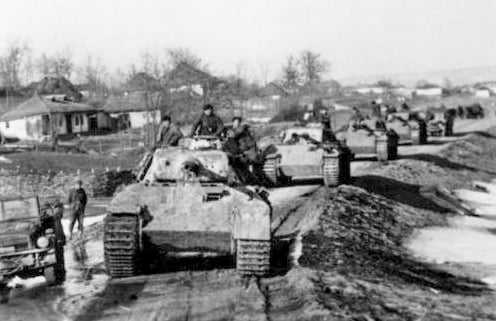Panzer-Grenadier-Division Großdeutschland

Panzer-Grenadier-Division Großdeutschland

| Panzergrenadier-Division Großdeutschland (Greater Germany) | |
|---|---|
| Active | 19 May 1942 – 25 April 1945 |
| Country | |
| Branch | Army |
| Type | Panzergrenadier |
| Size | Division |
| Part of | Expanded from Regiment to become Motorized Infantry Division 1942 and Panzer Grenadier Division 1943. |
| Garrison/HQ | Berlin, Cottbus, Okhtyrka |
| Nickname(s) | The Fire Brigade[3] |
| Engagements | World War II
|
| Commanders | |
| Notable commanders | Generalleutnant Hasso von Manteuffel Generalmajor Karl Lorenz |
| Insignia | |
| Cuff title | |
The Panzergrenadier Division "Großdeutschland"[1] (also commonly referred to simply as Großdeutschland[2] or Großdeutschland Division) was an elite combat unit of the German Army (Heer) that fought on the Eastern Front in World War II.
The unit originally started out as a ceremonial guard unit in the 1920s and by the late 1930s had grown into a regiment of the combined Wehrmacht German armed forces. The regiment would later be expanded and renamed Infantry Division Großdeutschland in 1942, and after significant reorganization was renamed Panzergrenadier Division Großdeutschland in May 1943. In November 1944, while the division retained its status as a panzergrenadier division, some of its subordinate units were expanded to divisional status, and the whole group of divisions were reorganized as Panzerkorps Großdeutschland.
| Panzergrenadier-Division Großdeutschland (Greater Germany) | |
|---|---|
| Active | 19 May 1942 – 25 April 1945 |
| Country | |
| Branch | Army |
| Type | Panzergrenadier |
| Size | Division |
| Part of | Expanded from Regiment to become Motorized Infantry Division 1942 and Panzer Grenadier Division 1943. |
| Garrison/HQ | Berlin, Cottbus, Okhtyrka |
| Nickname(s) | The Fire Brigade[3] |
| Engagements | World War II
|
| Commanders | |
| Notable commanders | Generalleutnant Hasso von Manteuffel Generalmajor Karl Lorenz |
| Insignia | |
| Cuff title | |
1939–1942
The Infantry Regiment Grossdeutschland was activated on 14 June 1939. The regiment saw action in France in 1940. It was attached to Panzer Group 2 in the opening phases of Barbarossa, and was nearly destroyed in the Battle of Moscow in late 1941. On the last day of February 1942, Rifle Battalion Großdeutschland (all that was left of the original regiment) was disbanded and two battalions formed a new Großdeutschland Regiment out of reinforcements arriving from Neuruppin. The regiment later moved to Orel after, and on 1 Apr 1942 the former Infantry Regiment Großdeutschland was expanded to the Infantry Division Großdeutschland.[4]
The Infantry Regiment Großdeutschland reorganized and expanded to become Infanterie-DivisionGroßdeutschland*(mot.)*. The division was assigned to German XLVIII Panzer Corps during the opening phases of Fall Blau, Wehrmacht's 1942 strategic summer offensive in southern Russia. During the combined Soviet winter offensives Operation Uranus and Operation Mars, the division fought near Rzhev, where it was rendered combat ineffective.
In January–February 1943, Großdeutschland and XLVIII.Panzerkorps, along with the II SS Panzer Corps took part in the Third Battle of Kharkov. The division fought alongside the 1.SS Division Leibstandarte SS Adolf Hitler, 2.SS Division Das Reich and 3.SS Division Totenkopf during these battles.[5] After the fall of Kharkov, the Großdeutschland was again pulled back and refitted.
1943–1945

Großdeutschland Division soldiers, Kursk, July 1943

Panzers of the division in Romania, 1944
The newly re-equipped division was subordinated to the XLVIII Panzer Corps, part of Fourth Panzer Army, and took part in the Battle of Kursk. During the buildup period, a brigade of two battalions equipped with the new Panther tanks, which were plagued by technical problems, suffering from engine fires and mechanical breakdowns before reaching the battlefield. By 7 July, the division had only 80 of its 300 tanks still fit for combat.[8] After the Kursk offensive was cancelled, the division was transferred back to Army Group Center, and resumed its role as a mobile reserve. The Tiger I tank company was expanded to a battalion, becoming the III. Battalion of the Panzer Regiment. Großdeutschland saw heavy fighting around Karachev before being transferred back to XLVIII Panzer Corps in late August.[9] For the rest of 1943, Großdeutschland retreated across Ukraine, and in 1944 into Romania, where it took part in the First Battle of Târgu Frumos.
In early August, the division was transferred to East Prussia from Army Group South Ukraine.[10] Over the next months, Großdeutschland was involved in heavy fighting in both East Prussia, including a counter-attack on Wilkowischken and the Baltic States, suffering large casualties in both men and materiel.[11][12] The division was nearly destroyed during the battles in the Memel bridgehead.
In November 1944, while the division and several attached units were redesignated as Panzerkorps Großdeutschland. By March 1945, the Panzer Grenadier Division Großdeutschland had been reduced to around 4,000 men after the Battle of Memel.[13] By 25 April 1945, the division was engaged in heavy fighting in the battles around Pillau.
War crimes
During the campaign in France, Großdeutschland carried out racially motivated murders of hundreds of captured black African members of the French army, which fell into the hands of the infantry regiment. The soldiers of Großdeutschland murdered captured blacks on account of their race, which they believed to merit their separation from white soldiers, and then their execution. For example, on June 10, 1940, at least 150 captured black soldiers were separated and murdered by Großdeutschland in the Erquinvillers area. On 19 and 20 June 1940, Großdeutschland carried out a series of massacres of captured blacks in the Chasselay area, in which the regiment together with the SS division 3rd SS Panzer Division Totenkopf murdered about 100 black soldiers for racial reasons.[14]
The book German Army and Genocide mentions the following incident, from the invasion of Yugoslavia:
When one German soldier was shot and one seriously wounded in Pancevo, Wehrmacht soldiers and the Waffen SS rounded up about 100 civilians at random...the town commander, Lt. Col. Fritz Bandelow conducted the Courts Martial...The presiding judge, SS-Sturmbannführer Rudolf Hoffmann sentenced 36 of those arrested to death. On April 21, 1941, four of the civilians were the first to be shot...On the following day eighteen victims were hanged in a cemetery and fourteen more were shot at the cemetery wall by an execution squad of the Wehrmacht's Großdeutschland regiment.— [15]
Part of the photographic presentation for the book includes a photo where the Großdeutschland cuff title on the officer is clearly visible. The subject of Grossdeutschland's complicity in many subsequent war crimes in Russia and Ukraine, was the subject of the book by Omer Bartov The Eastern Front, 1941–45, German Troops, and the Barbarization of Warfare (1986, ISBN 0-312-22486-9).
Organization
Headquarters
Grossdeutschland Reconnaissance Battalion
Grossdeutschland Panzer Regiment
Grossdeutschland Panzergrenadier Regiment
Grossdeutschland Fusilier Regiment
Grossdeutschland Engineer Battalion
Grossdeutschland Artillery Regiment
Grossdeutschland Tank Destroyer Battalion
Grossdeutschland Army Anti-Aircraft Battalion
Grossdeutschland Assault Gun Battalion
Grossdeutschland Signal Battalion
Grossdeutschland Divisional Supply Group
List of commanders
- Infantry Regiment Grossdeutschland
Oberstleutnant Wilhelm-Hunold von Stockhausen, July 1939 – February 1940
Oberstleutnant Gerhard Graf von Schwerin, February 1940 – March 1940
Oberst Wilhelm-Hunold von Stockhausen, Mar 1940 – August 1941
Oberst Walter Hörnlein, August 1941 – April 1942
- Infantry/Panzergrenadier Division Grossdeutschland
Generalmajor Walter Hörnlein - 1 April 1942 – 3 April 1943
Generalleutnant Hermann Balck - 3 April - 30 June 1943
Generalleutnant Walter Hörnlein - 30 June 1943 - 1 February 1944
Generalleutnant Hasso von Manteuffel - 1 February 1944 – August 1944
Generalmajor Karl Lorenz - 1 September 1944 - 7 May 1945
See also
Guy Sajer